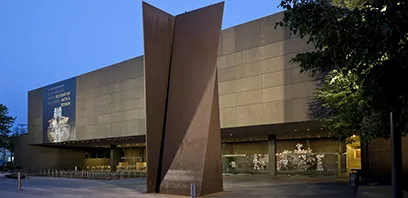The Magic of Flight
December 12-June 1, Rangos Omnimax Theater
Carnegie Science Center
The Magic of Flight was produced by MacGillivray Freeman Films for
the National Museum of Naval Aviation, Pensacola, Florida. It is made possible
through the sponsorship of McDonnell Douglas and F/A-18 Industry Partners:
Northrop Grumman Corp, Hughes Aircraft Company and GE Aircraft Company
and GE Aircraft Engines.
For millions of years, no one has had a better feel for flight than
birds. Only within the past century have humans discovered the means to
soar through the air with our avian friends. The Magic of Flight,
a new film at Carnegie Science Centers Omnimax Theater, brings the thrill
of flight and jet aircraft technology to the big screen, balancing the
excitement of a Blue Angel air show with the science and history of flight.
So buckle your seatbelts and join us for the ride of a lifetime in The
Magic of Flight.
The Epitome of Modern Flight
Talk about hair-raising experiences: Youre traveling upside down at 700
miles an hour, in the cockpit of an F/A-18 Hornetone of the U.S. Navys
Blue Angels demonstration jets. Youre moving so fast that G-forces, or
gravitational forces, are in effect. Thank goodness youre wearing a G-suit,
which renders the deadly forces harmless. Finally, after what seems an
endless trip through the clouds, youre back on solid groundand glad to
be there. Suddenly you have a new respect for the daredevils who pilot
the famous Blue Angels planes.
The sight of the sleek Blue Angels team soaring through the air in their
well-known delta formation is awesome, so much so that more than 27 million
spectators are turning out to see Blue Angels shows every year. This elite
group celebrated its 50th anniversary in 1996 and currently flies more
than 60 air shows in an eight-month season.
Piloting one of these demonstration jets is not a job for the timid,
and the complex maneuvers displayed in a performance show the discipline
and skill it takes to be a Blue Angel. These pilots are active duty members
of the U.S. Navy or Marine Corps. To qualify, they must have flown at least
1,500 tactical jet hours, earned career qualifications and demonstrated
superior abilities as naval officers and aviators. Each Blue Angel serves
a two-year tour, then returns to an operational unit at sea.
Early Attempts at Flight
It all started at the beginning of the 19th century. George Caley, Englands
“father of aeronautics,” was credited with the first major breakthrough
in heavier-than-air flight: understanding wing shape and lift. By 1808,
Caley had created a variety of fixed-wing model gliders, and not long afterward,
full-scale gliders. Legend has it that in 1853, Caleys coachman became
the first human to glide in the air successfully. But the harrowing experience
was too much for the man, and he abruptly gave notice, saying that he was
hired to drivenot to fly!
Some 40 years later, a German civil engineer named Otto Lilienthal came
up with 18 successful glider designs after studying bird flight and aerodynamic
theory for two decades. Lilienthals gliders were of common materials such
as willow rods and waxed cotton, and he launched them into the wind from
atop a hill. A late19th-century publication described the unforgettable
sight: “the spectacle of a man supported on huge white wings, moving high
above you at racehorse speeds.”
Meanwhile, in May of 1896, Samuel P. Langley, secretary of the Smithsonian
Institution, launched the first scale prototype, heavier-than-air, powered
model of his original “Aerodrome,” which flew a distance of 4,200 feet.
Unfortunately, the later, full-scale models proved successful only in depositing
the pilot into the Potomac River.
During the last decades of the 19th century, two brothers exercised
their creativity in projects ranging from initiating a school newspaper,
to manufacturing chewing gum from sugar and tar, to building and repairing
bicycles. With their natural mechanical abilities and restless minds, these
brothersOrville and Wilbur Wrighteventually took on flight as a new and
challenging project. After studying the previous 40 years of flying experiments
and corresponding with experts in the field, the Wrights began applying
their knowledge to the construction of a series of gliders. Their triumph
was overcoming Lilienthals problem of inadequate “weight shifting” by
“wing warping,” twisting the tips of an aircrafts wings in a manner similar
to that of a bird.
Initial tests of the Wrights gliders in 1900 at Kitty Hawk, North Carolina,
were disappointing. Through painstaking research and experimentation over
the next two years, however, they solved the stability and control problems
that plagued their earliest efforts. They invented the first operational
aircraft propeller and, with the help of their mechanic, Charles Taylor,
they built their own 12-horsepower engine. By 1903 their craft was ready
for powered flight.
On December 17, 1903, Orville wired a Western Union telegraph message
to his father. It read:
Success four flights Thursday morning all against twenty one mile wind
started from Level with engine power alone average speed through air thirty
one miles longest 57 seconds inform Press home Christmas.
But the plane was wrecked by a sudden gust of wind shortly after the fourth
trial; there would be no more flights that year, and in fact the Wright
1903 Flyer never flew again.
Blue Angels Trivia
Planes The U.S. Navy Blue Angels Flight Demonstration Squadron
has 11 jets and one turbo-prop transport. Some jets are built for speed
and maneuverability, and some for special landings and take-offs. The F/A-18
Hornet has a computer system that actually reconfigures the planes wings
in flight, like birds do instinctively. The JumpJet lifts off vertically,
like a helicopter, and moves forward as the wings create lift of their
own.
Speed F/A-18 Hornets can reach speeds of almost Mach
2 (1,400 mph), but pilots usually keep the speed below the sound barrier
for an air show. The fastest they will travel is 700 mph (just under Mach
1), and the slowest is about 150 mph.
G-Forces Blue Angels anticipate G-forces by contracting
muscles in the face, neck and stomach to stimulate circulation to the brain
and thus avoid blacking out.
Smoke The smoke emitted by the jets is created from a
paraffin-based oil that is squirted directly into the left engines exhaust
nozzle. When the oil hits the hot air coming from that engine, it is instantly
vaporized and turns into smoke. The smoke, which poses no threat to the
environment, provides a traceable path for spectators to follow, and it
enhances the safety of the solo pilots who must pinpoint each others positions.
Fuel On average, an F/A-18 uses about 8,000 pounds of
fuel (1,300 gallons) during an hour of flight time. The fuel is a special
jet aircraft mixture called “JP-5.”
Photographs courtesy of MacGillivray Freeman Films



